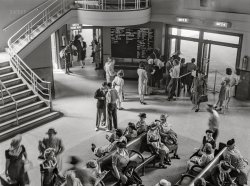
MAY CONTAIN NUTS

Search Shorpy
SHORPY ART

Framed or unframed, desk size to sofa size, printed by us in Arizona and Alabama since 2007. Explore now.
Join and Share
Ad-Free Shorpy
Shorpy is funded by you. Patreon contributors get an ad-free experience.
Learn more.

Recent comments
- Freeze Frame
- Texas Flyer wanted
- Just a Year Too Soon
- WWII -- Replacing men with women at the railroad crossing.
- Yes, Icing
- You kids drive me nuts!
- NOT An Easy Job
- I wonder
- Just add window boxes
- Icing Platform?
- Indiana Harbor Belt abides
- Freezing haze
- Corrections (for those who care)
- C&NW at Nelson
- Fallen Flags
- A dangerous job made worse
- Water Stop
- Passenger trains have right of way over freights?
- Coal
- Never ceases to amaze me.
- Still chuggin' (in model form)
- Great shot
- Westerly Breeze
- For the men, a trapeze
- Tickled
- Sense of loneliness ...
- 2 cents
- Charm City
- What an Outrage
- Brighton Park
Member Photos
The Shorpy
Print Emporium
Print Emporium
Search Shorpy
Search results -- 30 results per page
- OKC: 1942
- ... (seeds) and West Reno (Fords). Acetate negative by John Vachon, Office of War Information. View full size.
How did this not ... Posted by Dave - 01/12/2024 - 12:51pm -
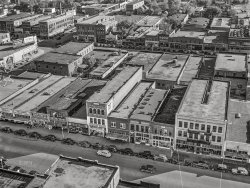
- Apolitical Animal: 1942
- ... capitol." Yea or neigh? Medium format acetate negative by John Vachon for the Farm Security Administration. View full size.
That would ... Posted by Dave - 01/07/2024 - 12:12pm -
![Apolitical Animal: 1942 February 1942. "Bismarck, North Dakota. State capitol." Yea or neigh? Medium format acetate negative by John Vachon for the Farm Security Administration. View full size.
That would be a yeaYes, that is the state capitol in Bismarck. Below is from another angle, as seen by me in December 1989. In both photos, it was freezing.
I did not encounter a friendly horse on my visit. Instead, I found myself in the mean-ass stare of a buffalo, made of rebar. On the capitol grounds is also a memorial to veterans of all wars. There is a hole in the roof, placed so that at 11am on November 11th, a ray of sun shines upon the bronze globe. And, very similar to the Vietnam Wall in D. C., the names of those who gave their lives, right up next to you, grouped together in way too many conflicts. Very thoughtful and impressive.
"The ayes have it".According to my heads-up count.
Deco SchmeckoThat ugly building is supposedly Art Deco in style but it looks like Brutalism to me. Wish I could unsee it.
Tom SwiftyShelby Foote introduces politics in General Lee calling for his horse Traveller to be brought: "Orderly! Orderly!" he called hoarsely, not seeing Tucker close by with Traveller, whose bit had been slipped to let him graze.
[I had a pony named Hoarsely. - Dave]
Human affairsI think the horse’s opinion on human politics can be found behind his left rear leg.
At Twenty One StoriesThe capitol building was completed in 1935, and still is the tallest occupied building in the state.
Is this circa 1963 Bulgaria?All that's missing is the typical giant mosaic of Lenin leading the way for the apparatchiks and peasants.
Still on the fence?I like this post!
(The Gallery, Horses, John Vachon, Landscapes, Politics)](https://www.shorpy.com/files/images/SHORPY-8c21278a.thumbnail.jpg)
- Pearl Harbor Bar: 1942
- ... Libation station for the Duration. Acetate negative by John Vachon for the Office of War Information. View full size.
Infamy in a ... Posted by Dave - 12/07/2023 - 3:37pm -
![Pearl Harbor Bar: 1942 October 1942. "Tulsa, Oklahoma. Gas station converted into a bar." Libation station for the Duration. Acetate negative by John Vachon for the Office of War Information. View full size.
Infamy in a boothThis was looking north(west-ish) on Main from Ninth.
To the disappointment of many, I imagine -- but the surprise of few -- it's currently a vacant lot. The PHB seems to have lasted at least a few years, mostly making the pages via the police blotter: various nefarious goings-on which recalled the namesake in all the wrong ways.
[Meanwhile back at the mall, City Briefs is now called Urban Underwear. - Dave]
Ah yes, next to Wisenheimers.
But back to our station, it seems to have started life under the Rainbow Oil Company
operating under a number of titles - "filling station", "service company" - and mottos.... "Limp in and Leap out!" scored well on the Cleverometer
A question of tasteIt's difficult for me to imagine a "World Trade Center Bar" in early 2002.
Matriarchical neighborhoodThe full name painted on the window is Ava's Pearl Harbor Bar, right across the street from Cathey's Furniture. I guess it was a time when women brought home the bacon and fried it up in a pan.
Seldom seen nowI had a good buddy who was an accomplished artist and a sign painter. He had to make ends meet, ya know. I always liked being able to identify his signs by the signature applied in one corner or the other. Now, with more and more signs done in other mediums, that characteristic is nearly vanished. Gone with the painter's touch under the modern vinyl or something. So, it was a pleasant thing to see the proudly added signature of "Cruzan" above the alcove's header. Hope he did well for himself, and my friend too. Nice picture, Dave.
Keys, keys, keys!I think they also make keys.
Out of luckProperty looked good, apparently a vacancy as well -- just had to make it over to "1102 So. Boulder" to make an inquiry. Alas, the owners seem to have permanently moved out, like the Pearl Harbor Bar itself.
LovelyA technically beautiful photograph. Great contrast. The diagonal slash of sunlight across the upper reaches of the dark-brick building in the background is mesmerizing.
That posteron the right side of the building is, I believe, this one.
Easier to sayI would have named it Pearl Harbar.
Near two main streetsThe owner's choice of an eye-catching name for the business may relate to its proximity to "The Main Street of America - Route 66 (which passed a block or two south of the intersection of Main Street and Ninth Street in Tulsa). No doubt the "Pearl Harbor Bar" name appeared among the many billboards facing those whose non-replaceable tires (and soon, ration stamps) enabled them to travel by car or truck during wartime.
Tough state to own a barOn Oct. 24, 1942, after what photographer Vachon called his "two wonderful wasted sunny weeks in Tulsa," he complained in a letter to his wife Penny written in Oklahoma City's Biltmore Hotel that "this hotel, in this dry state, has a nice bar for army or navy officers only." In 1942 Oklahoma was mostly dry; hard liquor was illegal but watery beer (not more than 3.2% alcohol) was legal. (The governor and AG didn't concede an exception for military personnel, and tried and failed to convince the Supreme Court to let it keep whiskey seized en route from St. Louis to Fort Sill's officers club.) So with vast numbers of young men temporarily encamped or employed within Oklahoma's boundaries due to the war, an off-base bar like the Pearl Harbor could barely benefit from it.
Tulsa is confusing!For those of trying to figure out where this is - Google informs that there are no fewer than 5 intersections between "9th Street" and "Main Street": N 9th & W Main, W 9th & N Main, E 9th & S Main, E 9th & N Main, S 9th & E Main; there may be more, google only ever lists five suggestions.
If internet chatter is to be believed, Pearl Harbor Bar was where E 9th turns into W 9th as it crosses S Main.
(The Gallery, Eateries & Bars, Gas Stations, John Vachon, WW2)](https://www.shorpy.com/files/images/SHORPY-8d09182u.thumbnail.jpg)
- Yard Cop: 1942
- ... tank car in the yards." Medium format acetate negative by John Vachon for the Office of War Information. View full size.
The trusty ... Posted by Dave - 12/04/2023 - 11:27am -
![Yard Cop: 1942 October 1942. "Tulsa, Oklahoma. Mid-Continent Petroleum Corp. refinery, Tulsa station of the Great Lakes pipeline. Armed railroad guard inspecting an oil tank car in the yards." Medium format acetate negative by John Vachon for the Office of War Information. View full size.
The trusty WinchesterI've seen pictures of the yard cop with a night stick. Winchester is the baseball bat. I guess for the war effort and saboteurs?
Changing job focusA few years earlier the railroad yard cop would have been after hobos; movies of the 1930s have many such scenes. By 1942, war and economic activity had largely solved the hobo 'problem'. Now the concerns were sabotage, theft of raw materials, and security in general.
The Case of the Missing Journal LidSomeone obviously pilfered it! The oil-filled journal box should have a snug-fitting cover, as seen on the one at far left, to keep rain water and road dust out of the bearing area. The journal box closest to the gun-toting lawman seems to have taken its leave?
Black and White HeatA rifle ... next to an oil tank(er)??? Guess he didn't see the movie (But he had a good excuse: it wouldn't be released until seven years later)
Vintage graffiti?I hadn't thought about graffiti in 1942. But then why not. Much less ugly than spray paint!
[Those are yard-crew markings. - Dave]
How StylishIn a three-piece suit & tie complete with handkerchief, this fellow seems quite overdressed. Railyards (especially in the days of steam locomotives) were very dirty places. Bib overalls would have been more appropriate. Maybe he spends time in an office or just wanted to look good for Mr. Vachon's camera.
(The Gallery, John Vachon, Railroads)](https://www.shorpy.com/files/images/SHORPY-8d44981a.thumbnail.jpg)
- Big Mack: 1942
- ... oil at the Mid-Continent refinery." Acetate negative by John Vachon for the Office of War Information. View full size.
Factory Fresh ... Posted by Dave - 12/05/2023 - 12:31pm -
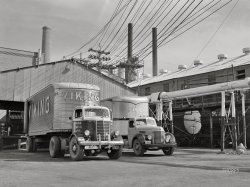
- Esso Extra: 1942
- ... had certainly improved the look of stations since John Vachon photographed one two years earlier.
The smoking section A fine ... Posted by Dave - 01/15/2024 - 11:46am -
![Esso Extra: 1942 December 1942. "New York, New York. Girl at gasoline pump." Medium format acetate negative by Royden J. Dixon for the Office of War Information. View full size.
Outfit materialVelour? Corduroy? It has a soft, plush look.
8 cents per gallon?Am I reading the price correctly on the gas pump?
[Um, no. - Dave]
Fill 'er Up!Tell me that's not Ethyl manning the pumps!
Neatness countsWomen employees had certainly improved the look of stations since John Vachon photographed one two years earlier.
The smoking sectionA fine example of modern looking "computer" pumps, at least if we ignore the archaic sight-glass (and those weird dome tops, that give them the appearance of small mosques).
What particularly caught my eye, however is the curious(ly skimpy) "No Smoking" signage: the placement gives the illusion that the proscription only applies to the regular grade
That is no girl!An adult woman, to my eye. But those were different days.
"Extra" pumpsWonder why there are two "extra" pumps sitting inside the station in the background apparently not (yet) in use. Maybe the station was in the process of converting over to the "new" style pumps and that's what motivated this photo.
[There are pumps on both sides of the island. What motivated the photo is wartime girl station attendants! - Dave]
Price per gallon todayAdjusted for inflation, 20 cents in 1942 would be $3.83 today.
Outfit material continuedI guessed it might be cotton velveteen?
Want to feel old?Few people who are less than solidly middle aged have seen gasoline pumps that show a sale's cost with only three digits. Yet before the 1973 oil embargo they were ubiquitous.
PeekabooI wonder who is that hiding behind the bulk oil dispenser? Doesn't appear to be wearing a pump jockey uniform.
When People Didn't Throw Away Pennies8 and 10 cents a gallon are $1.56 and $1.95 in today's dollars.
[The prices on these pumps are 18 and 20 cents a gallon. - Dave]
Mystery equipmentWhat is the equipment on the right in front of the two pumps and the person in black on the back side of the island?
Gas Is Less Expensive Today If 20 cents equals $3.83 today, one must remember that cars today get almost twice the mileage they got back then. So back then to go to and from the same distance as one would go today it would cost them 40 cents, adjusted for inflation should mean that gas today should be $7.66.
IMO, the reason we think gas prices are so high is because of all the "stuff" we simply must have that did not exist back then, like computers, cable TV, the Internet and more, that comes out of your paycheck each month. Take all that away and $3.50 a gallon would be less a drain today than 20 cents was back then.
In Case of Fire ... There is a handy soda-acid fire extinguisher hanging on the wall to the left. It appears that there was some wear and tear on the filler hoses dragging on the ground. The fix was to wind some heavy rubber tubing around the area on each hose. The Imperial Oil Company in Canada still uses the name Esso for its gas stations.
Silver LiningCoins were made from real silver back then! Take that into consideration when adjusting for inflation.
(The Gallery, Gas Stations, NYC)](https://www.shorpy.com/files/images/SHORPY-8d09847u.thumbnail.jpg)
- Wisdom, Montana: 1942
- ... in ranching country." 4x5 Kodachrome transparency by John Vachon for the Office of War Information. View full size.
Superb ... Posted by Dave - 11/03/2023 - 1:14pm -
![Wisdom, Montana: 1942 April 1942. "Baker's Garage in Wisdom, Montana. Largest town, population 385, in the Big Hole Basin, a trading center in ranching country." 4x5 Kodachrome transparency by John Vachon for the Office of War Information. View full size.
Superb quality!The quality of this photograph is amazing. It looks like it was taken today. Do you have any more information on it?
Wisdom MTGoogle Maps link.
WisdomGreat photo. Thanks. The last remaining inhabitants eventually changed the name to "Boredom, Montana."
Towns like thisTowns like this are a staple of western North America. In western Canada, their existence was justified by the railway and farmers hauling grain to their local elevators. Later they survived when the highway became the big thing and people stopped for gas or a little food on the road. There's probably a bar that the locals go to. Town's got a school maybe even a high school, and probably more than one church. There's a ball field and, in just about every prairie town in Canada though of course not the USA, a curling rink. In Saskatchewan they used to say that if you lived in a town that lost the school and the curling rink you might as well start looking for a place in Saskatoon or Regina.
PennzoilThe Pennzoil logo hasn't changed much:
WidsomIt looks like it's on the edge of a river valley? The colors in this shot are indeed amazing. I love the punch of the red gas pumps.
[It's west of Butte. - Dave]
CalsoWhat does it say on the sign leaning against the wall, underneath "Calso Gasoline"? Is that "Unsurcharged"? No extra fees?
["Unsurpassed." - Dave]
Eternal WisdomUnderneath "Unsurpassed" on the Calso sign you have "The California Company"
I found a modern picture of this place online:
http://www.panoramio.com/photo/4494303
Aside from the paved road, this place looks much the same. I don't think they sell Chevron or Mobil at those buildings anymore. Baker's Garage is now Conover's Trading Post. The painted Wisdom has long since faded from the old metal roof.
The GarageI was raised and went to school in wisdom and Bakers Garage is not next to Ed Glassey's garage (The building with Wisdom on the top). Baker's Garage was across the street from Glasseys Garage (Looks like maybe they used photoshop to alter the photo) ..
I moved to Wisdom in 1959 so if the photo is from 1942 maybe they moved the Building??
[The image, which is part of the Library of Congress photographic archive, has not been altered. It's one of more than 50 pictures of Wisdom taken by John Vachon in April 1942. Things can change a lot in 20 years. - Dave]
Baker's Garage in WisdomI am a Wisdom native too.
In talking to my dad. Bruce Helming, who is the oldest native still living in Wisdom, it turns out that Anna Lee and Roy Baker did own a shop across the street from the garage that you know as Baker's, which is now the Wisdom Market. It was the Chet Bruns Union 76 Garage back in the old days. Anna Lee was my dad's first cousin. Dad's folks adopted her when her parents died in the 1920s, and she was raised as Anna Lee Helming in Wisdom.
My grandparents' (and later Dad's) business, Helming Brothers, bought out Chet Bruns' operation in the 1950s, which is when Anna Lee and Roy moved to the garage that you know now. The buildings shown in the photo were destroyed in the American Legion hall fire. I would guess that was in the early 50s, which is when all of the cemetery records were destroyed.
Wisdom had no real fire department until 1961, so when a blaze was raging out of control, it was extinguished by placing dynamite in a loaf of bread and tossing it into the fire. The night the Legion hall and all of these other buildings burned, Dad and his uncle, Clarence Helming, were bringing the fire pumper to the scene. Just as they rounded the corner, "Boom," no more fire (and no more buildings).
Gary Helming
Helming@juno.com
Pictures of Wisdom, MontanaI enjoyed looking at the old pictures of Wisdom and reading the text about them. I grew up near a small town (Gladstone, VA) and have always been kind of partial to them. I love looking at old pictures like these. Thank you for posting them.
The Wisdom of YouthThis town holds a place in my heart. I spent most of my youth in Wisdom, from 1975 to 1990. The town hasn't changed a lot since I left, but has gotten smaller. When I started at Wisdom Elementary there were four classrooms. By the time I graduated to high school they were down to three. I hear there is only one class there now. For high school we were bused 65 miles to the Dillon, one of only two high schools in the county.
It was an amazing place to grow up. Though everyone knew your business, everyone kept an eye out for you. We had two bars that all the kids hung out in and played pool. There were street dances for the Fourth of July and any other occasion. There were two restaurants, one of which burned down last week.
It is hard to describe the life that a kid in a town this small would lead. The concept just doesn't make sense to city folk. But it was an amazing carefree life of swimming under the bridge, ice skating at the pond, nights of kick the can in the Forest Service field, greetings from the town's pet deer and raccoons.
If it were possible to have the kind of lifestyle I have now in the city, I would move back to raise my child there in a heartbeat.
Having lived near Wisdom for many yearsduring the summer-time, I can almost see the buildings. We haven't lived in Jackson for 20 years but the previous 8 years were spent on the Hairpin Ranch in a line shack about 5 miles past the main ranch, in the middle of nowhere. I loved EVERY minute of it. We traveled to Wisdom for dinner some days or just when the kids wanted to take a ride. It was a short 20 mile drive. Would move back in a New York minute.
Early pioneers of the Big HoleI'm looking for any pictures or info of the early Wisdom families prior to 1930. I have an old school picture dated 1914/15 and would love to have someone help identify the children. Both sides of my family, the Elliott's and Scollicks were early settlers there. The old dilapidated log cabin on the south end of the Ruby near Butler Creek is the Scollick homestead and the Elliott log cabin is on Gibbonsville road. I believe my Aunt Eve Scollick might have married a Ferguson in the Wisdom area. There's a picture hanging at the Crossing/Fetties with several people on horses. Anyone that can help identify them as well would be great.
(The Gallery, Kodachromes, Gas Stations, John Vachon, Rural America, WW2)](https://www.shorpy.com/files/images/1a34284u1.thumbnail.jpg)
- Trucks Akimbo: 1939
- ... at farm implement warehouse." 35mm nitrate negative by John Vachon. View full size.
Looks like scale models in a set. ... "Mister Rogers' Neighborhood." One almost expects to see John Garfield step out of that doorway.
"Wheeler" Now there's ... Posted by Dave - 09/13/2011 - 8:18pm -
![Trucks Akimbo: 1939 September 1939. "Minneapolis, Minnesota. Trucks loading at farm implement warehouse." 35mm nitrate negative by John Vachon. View full size.
Looks like scale models in a set.Particularly everything from the train tracks up. The lower section doesn't have the sheen or something to carry it off.
The two guys in and around the truck don't help either.
I wondered at firstLooking at the top half of the picture I almost thought it was one of those amazingly detailed models we see occasionally, but then I saw the guy hanging out of the truck window bottom left!
ToysThis looks like a bunch of toys. If only it was also a tilt/shift photograph.
Traffic JamLooks like a game of Traffic Jam with 30's vehicles.
ModelesqueI know the photo is real, but it looks like one of Michael Paul Smith's images.
Tonka! This so looks like a kid's play area with all his little cars and trucks. Hope he isn't in the mood for an accident.
Slightly SurrealThere is a definite air of artificiality here, in spite of the fact that this
is an authentic photograph of a real-life scene. Is it the rakish angle?
The floating-above-it-all perspective? It screams "scale model" as in
a contrived cityscape in a model-enthusiast's basement.
1934Never mind the big Minneapolis truckers strike in 1934, in which the National Guard was called in to shoot the strikers in the streets. It's a big deal in Labor history, particularly in Minnesota. But have fun with it.
Doublemint twinsI had no idea their ad concept went back that many years.
The year before I was born!Amazing that this was possible with 35mm, but if you examine the photo carefully you wil see that only the truck in the upper center is in really sharp focus.
Great Northern Freight YardI believe this is one of the freight houses behind the GN depot in Minneapolis. The yard was bisected at 4th Avenue North, where I think the 1939 photo was taken. There is one remaining building that is today used for housing.
Don't pass on the rightI found it interesting that the truck crossing the tracks only had a mirror on the right side. I though that may have been a traffic hazard till I noticed that none of the many vehicles had side mirrors at all!
WOW, Clean!!!!I am amazed at how clean this area and the trucks appear. Very little litter laying around and absolutely ZERO graffitti. Of course the spray paint can wasn't invented yet.
Batman!This totally looks like a panel from a Batman comic.
AkimbophileGood to be able to use a word like "akimbo" any time. A wonderful word that is perfect. It just rolls off the tongue so nicely. And works well in Scrabble at times.
City lifeCity life in the forties. Cars and trucks had awesome designs.
MatchboxesLooks like somebody's Matchbox collection in an HO scale layout.
A guessSomehow I think the guy hanging out of the window in the truck in the center of this started off his conversation with "Hey Lou!"
DizzyThe angle of the shot actually makes me dizzy.
Or the Untouchables!Which truck has the booze, and will Ness find it in time? They'll be headed back to the border for more if he doesn't!
Something's FishyOkay, I'll stick my neck out. I think these are scale models; cars, trucks and building. The vehicles are all too clean and perfect. No loading docks in sight, nor one human. That was my first impression yesterday and it's still my impression today.
[There are at least five people in the photo. - Dave]
Science is Helpless Also looks like a miniature set from a "Beast From 20,000 Fathoms" type movie. I'm waiting for a lizard to stomp on some of these cars and trucks.
Dioramais what this almost looks like except the people and the papers in the gutter say otherwise.
SurrealThis picture has an otherworldly quality, particularly when one views the full size version. The angles are unsettling and chaotic, and the vehicles begin to look like tiny toy model versions of their real selves. It's like a noir version of the intro to "Mister Rogers' Neighborhood." One almost expects to see John Garfield step out of that doorway.
"Wheeler"Now there's a perfect name for a transportation company.
Fourth AvenueThe "Freight Station" belonged to the Chicago & North Western Railroad on Fourth Avenue North near First Street. The building still survives, although has no railroad track anymore. Angle of the photo suggests it was shot from the roof of long-gone Security Warehouse.
1. A 1982 view.
2. Bird's eye view.
I see I'm not the only one that sees this as a model. So I looked at the image again and came up with some reasons why I think it looks like a miniature.
The angle of the camera doesn't seem to have any effect on the miniature. I rotated it, and still looks small.
I think the main reason is the lack of any harsh shadows and bright highlights. It could be early morning, or a cloudy day. A couple of trucks in the foreground do have sun on them, and the illusion seems to fail there. The way the cars are parked may have something to do with it. They are not perfectly parked by today's standards, and the guy on the sidewalk is asking for a ticket. The softness of the details in the above half also lend to the fact that the cars look die cast, and lacking in detail of a full size auto. Lastly, the angle of the shot is from somewhat of a humans eye view if they were looking down onto a table top. That's about it.
Supreme exampleAfter New York's police commissioner banned trucks with advertising sideboards (like the Doublemint ad on the Railway Express truck in lower right), Railway Express Agency tried but failed to convince the U.S. Supreme Court to overturn the regulation. In the 1948 decision, Justice Douglas added that "the fact that New York City sees fit to eliminate from traffic this kind of distraction, but does not touch what may be even greater ones in a different category, such as the vivid displays on Times Square, is immaterial."
C&NW Freight StationThe "Freight Station" is the building seen on the right in this Street View. Below that is another shot by John Vachon of the same scene.
View Larger Map
Memo to the "model" crowdTo avoid further embarrassment you might want to check out the other pics in this series.
John VachonShorpy-ites will be gratified to know that a book of John Vachon's photos was just added to the Library of Congress's excellent "Fields of Vision" series--along with Esther Bubley and Jack Delano!
Not a modelTook me a while, but before I looked at the other pictures I decided that while the angle certainly helps mess things up, what really got me was that the sizes of the trucks in comparison to that of the cars are smaller than they are today. I'm used to seeing trucks that are wider, or longer, or both. The "Wheeler Transportation" truck is what starts the whole "it's a model!" thing off for me. It looks like it doesn't belong, and, therefore, nothing else does, either.
At least until you look at the detail of the street cobbles, the weathering on the wheels, and etc., that is.
The Jack Greaves truck is the weirdest, with a bed that looks like a model bed, a person in the window that could go either way, but wheels that look like they are carrying a truck's worth of weight, which is something you never see in models.
Weird.
Shifty lookThe out-of-focus, tilt-shifty look in many of the pictures taken with these early 35mm Leicas was due to the film not being in entirely the focal plane. You had to be very careful loading. A redesign of the camera back around 1940 took care of the problem.
Real PeopleI am not certain how you all believe that this can be a model with those people in the picture. Sure, it looks a bit like toys but the people are hard to fake.
DoublemintLove the early Otis Shepard Doublemint gum billboard.
Otis Shepard's Doublemint twinsI love the Otis Shepard illustration on the side of the truck, too. I don't have an image of that particular one, but I do have color images of two others from the same campaign:
RE: Fourth AvenueThe building labeled "Freight Station" still exists and is residential. The building just out of the frame on the left side is the original Lindsay building, also now residential.
It's lowest level can be seen in the photo added by "Anonymous Tipster" on 5/20/2010.
RE: johnhill_3009 on Tue, 05/18/2010
The Security Warehouse building is still very much standing today (and yes, residential). Unless there was another building named Security Warehouse, it's much too far away (about 250 yards) to provide that perspective.
(The Gallery, Cars, Trucks, Buses, John Vachon, Minneapolis-St. Paul)](https://www.shorpy.com/files/images/8a04680u.thumbnail.jpg)
- Box Score: 1942
- ... for the Office of War Information. View full size.
Vachon Vision Ms. Collins seems to have taken composition lessons from the groundbreaking John Vachon.
Bow in Her Hair Too cute. Just too cute.
(The ... Posted by Dave - 02/15/2012 - 5:05pm -
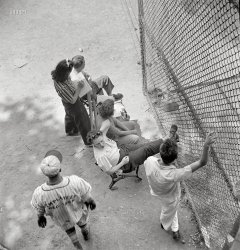
- Tidewater Texaco: 1941
- ... County, Virginia." Medium format acetate negative by John Vachon for the Farm Security Administration. View full size.
Match or ... Posted by Dave - 02/12/2021 - 12:19am -
![Tidewater Texaco: 1941 March 1941. "Gas station. King William County, Virginia." Medium format acetate negative by John Vachon for the Farm Security Administration. View full size.
Match or MarchI hope it's not match, given the possibility of fuel present, and the possible significant distance to a fire station ... but at any rate, I love the shepherd's hook signage on this Texaco. When I was little, in the late '50s until the mid '60s, my small family (mom, stepdad, sister, and me) were constantly on the move, virtually itinerant in a stolen baby blue Nash Rambler, in whose back window I slept. I loved rolling into a filling station because once you heard the ding, Mama started looking around for the Coke-Cola machine. I scanned the sky outside my backseat window mile after mile for the big yellow Shell shell, or the red Texaco star, or the green Sinclair dinosaur, or the sinuous Esso logo, hoping that a frosty glass bottle of sodey pop could be in my near future. Fly in the ointment: it saddened (well, angered) me that I always had to share with my big sister. Which meant, grab it out of her hands whenever I had the chance. I don't see refreshments here so let's move on before the whole thing blows sky high.
I’ll have a grape Nehi!The only ads I see. It’s either tires or a Grape Nehi!
Edit: the picture reminds me of the upper peninsula of Michigan.
NokesvillePicryl.com locates this on King Richards Court in Nokesville, which is about 10 miles southwest of Manassas. I do hope that nice big pine tree was spared during the
inevitable urban development and expansion of the roadway.
[Nokesville is in Prince William County. Our photo was taken in King William County, a hundred miles away. - Dave]
Southern PinesThe large pine tree here drew my attention immediately. Having grown up in the south, pines were a part of my existence. We lived in a trailer park that had once been a plantation, now grown over with 50+ year old pine trees that towered over our yards. Each year a storm or a tornado would topple one of these trees and slice through a trailer like a knife through soft butter. Needless to say I grew up with a fear of bad weather.
Rough Neighborhood?Are those bars on all the windows? Seems like a little overkill for a one-pump station out in the sticks. Perhaps running a gas station was a very lucrative enterprise back in the day!
Another Fantastic VachonHis work is consistently amazing to me. For the second time, I purchased a print of his from Shorpy (sorry if that sounds like an endorsement - it is!).
The thing that strikes me (living thirty miles away from this scene, is that I can see the sky at the top of the frame, in a deep blue. Thanks, John Vachon - and Shorpy.
Root 66I thought the same thing re: the iron bars. I wondered briefly whether the filling station housed the jail. Barney Fife would know the answer.
Isolated LocationI was just thinking that the bars on the window were there because otherwise the humble establishment would be a softer target. I imagine when the shop closed up it didn't have the benefit of nearby buildings or persons who could witness a break in by someone traveling by.
(The Gallery, Gas Stations, John Vachon)](https://www.shorpy.com/files/images/SHORPY-8c19157a.thumbnail.jpg)
- Mildred's Place: 1938
- ... coming to North Platte." Medium-format safety negative by John Vachon. View full size.
Letter from John Vachon to his wife, Penny:
... Posted by Dave - 08/02/2017 - 11:42am -
![Mildred's Place: 1938 October 1938 at the Alamo. "Mildred Irwin, saloon singer at North Platte, Nebraska. She entertained for 20 years in Omaha before coming to North Platte." Medium-format safety negative by John Vachon. View full size.
Letter from John Vachon to his wife, Penny:
October 29, 1938
Last night I had an adventure. Of the 1st water. To have it I had to get kind of stiff. And I did, dear. Pretty plastered. But it was all in the line of duty, eminently legitimate and justifiable. About eight o'clock I went into a corner saloon. It was a saloon in the grand tradition. I drank only beer, but great gobs of it. At the piano was a big huge large fat blonde woman of 45 to 50 yrs. With beautiful smeary red makeup on her puss, and huge mammy type bosoms. And her voice, O that you could hear her voice. She has Sophie Tucker in the wastebasket . . .
Hah!The boys at the bar look like they're rethinking the idea of moving to North Platte!
Mildred IrwinApparently she was a popular entertainer in her day. You can buy her CD (or just listen to her bang out "Little Rock" on the piano) here: http://www.croscrane.com/mildred.htm
John on MildredMr. Vachon may have had photog skills, but he's not too bad with a pen, either. Pretty colorful descriptions. The phrase...1st water...which I've heard only occasionally, seems used in the same sense as 'of the first order'. But 1st water also makes me think that it refers to bath water which in earlier times was a shared commodity. Handed down, so to speak. And first water would be, obviously, the first and best. We kids had to share bath water a lot back in the 50's, that part I do know.
I'll definitely have a listen to the link. Now to figure out what he meant by Sophie Tucker in the wastebasket.
[He means Mildred is the better singer. She puts Sophie to shame. - Dave]
Piano tuner neededI listened to the clip on the web site posted by Mattie. Either that piano was badly in need of tuning or Mildred Irwin preferred to use some bizarre non-Western scale.
First WaterThe phrase "Of the first water" comes from gemology.
Mildred's Audio ClipThat's the music I hear in my head when I think of "honky-tonk." That was great!!
Did you see the disclaimer?Here's the disclaimer on that site:
DISCLAIMER The music on this compact disk is a studio re-creation. It is not an actual recording. We do not wish to mislead anyone into believing that Mildred Irwin -- a real entertainer who played the piano at the Alamo Bar, a real bar in North Platte, Nebraska -- actually played the music you hear on this disk. She did not. As described in Charles M. Von Rosa's notes included in the booklet inside, this music was re-created using the limited information available. Like the bulk of the music heard on the radio these days, this music is fake. However, as our purpose is to honor a long neglected fabulous entertainer, here it is. We sincerely hope you enjoy this recording as much as we enjoyed putting it together. - Croscrane™
Audio ClipActually, if you read the fine print on that site, it basically says that audio file has nothing really to do with Mildred except being inspired by her. It's a modern recording intended to sound old---and to my ears it sounds much like a midi file, which they didn't even have in the '30s. Kind of a questionable tribute to the lady, really...
Not a vintage recordingDid anyone read the disclaimer towards the bottom of the page Mattie linked to? It says it's a studio re-creation of Mildred's playing...doesn't say when it was re-created...could've been a year ago.
Mildred (Not)I missed the disclaimer. I bet Mildred wouldn't be happy with that. Too bad there are no actual recordings of her playing.
Pat AstMildred is the spitting image of Pat Ast.
Mildred IrwinI live in North Platte and do alot of local historical research. I've seen all the pictures of Mildred that John took through the Library of Congress website. My question is what happened to Mildred after she left North Platte? I can't seem to find any references to her anywhere.
Just curious.
Mildred is mentioned here"It was John Vachon, however, who met the most audacious array of non-conformists, and he quickly fell under their spell. He eagerly photographed one old man who lived in the town dump and who "displayed a magnificent sense of humor." Somewhere near Big Hole, Montana, Vachon made friends with a sheep rancher, who took him deep into the range country, cooked him a meal in the open, and gave him his first horseback ride. (This fellow was hardly the defeated victim that Nathan Ache's sheep herder had been.) Although Vachon felt the rancher was an 'individualistic type which has probably outlived its usefulness,' Vachon still thought this character was the salt of the earth and an irresistible subject. But it was in North Platte, Nebraska, that Vachon found his greatest infatuation. At a local bar he discovered Mildred Irwin, "a big fat blond woman of 45 or so, with a beautiful red smary paint job." She had been an Omaha prostitute for nearly twenty years and had then retired to North Platte to play honky-tonk piano in the bar and sing "like Sophie Tucker--only very nasty songs." Completely smitten with this woman, Vachon took picture after picture of her, and "made 3 trips back to the hotel for more flash bulbs." By the late 1930s and early 1940s, documentary photographers were increasingly on the lookout for the likes of Mildred Irwin and searched less and less for subjects like Lange's "Migrant Mother". As conditions slowly improved and the crisis receded, it seemed less important to promote social legislation or confront the "realities" of the decade, and documentary photographers gradually turned to savoring the eccentricities of the people they met."
from Hope Among Us Yet: Social Criticism and Social Solace in Depression America
By David P. Peeler
University of Georgia Press, pp 105-106
(The Gallery, Eateries & Bars, John Vachon, Music, Omaha)](https://www.shorpy.com/files/images/SHORPY-8b14115a.thumbnail.jpg)
- The Singing Kings: 1965
- ... The King Family ." 35mm Kodachrome transparency by John Vachon for Look magazine. View full size.
Robert Clarke is probably ... Posted by Dave - 04/08/2023 - 7:57pm -
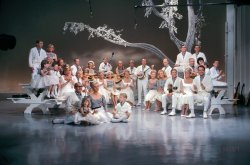
- Making Omaha Famous: 1938
- ... bottle battle of Storz vs. Metz. 35mm nitrate negative by John Vachon. View full size.
Grain alcohol 190 proof will sure do the job ... Posted by Dave - 08/02/2017 - 9:21am -
![Making Omaha Famous: 1938 November 1938. "Liquor store signs." In Omaha, Nebraska, it was a beer bottle battle of Storz vs. Metz. 35mm nitrate negative by John Vachon. View full size.
Grain alcohol190 proof will sure do the job if you want to get knee walking drunk.
Can you say"cheap drunk"?
Three-light signals!When I was a boy in New York City we didn't have three-light signals in my neighborhood until the early fifties. Omaha must have been on the cusp of high-tech.
Location?The next photo taken by John Vachon shows the street going downhill towards a business district.
Can anyone ID this intersection?
Dave, what's with the holes in half the photos in this series at the LOC site?
[The FSA photographers used hole punches on 35mm negative strips to show rejects -- exposures they didn't want printed. - Dave]
I think I feel sickJust imagining what could happen with the products advertised and the prices being charged gives me a serious headache and nausea.
They deliver?"Hello, I've fallen and I can't get up. Could you please deliver a gallon of Sweet Empire Wine? Thanks much! Oh, when I was last in I forgot to mention how taken I was with the old porch post which you have so cleverly repurposed as a utility pole."
The Parallel Parking Sign....on the utility pole out front. Is it for airplanes or land vehicles?
Copyright InfringementI can hear Jos. Schlitz saying "Get my lawyer on the phone! I want those bums at Metz in Omaha driven out of business today. They can't steal my slogan!"
A dime'll get you doubleOkay, so I noticed that grain alcohol, while ten cents higher than Seagram's, was likely more than twice the proof. Maybe I need help.
Decisions, DecisionsA gallon of wine for a dollar one-nine or a pint of grain for less than a buck? I'll take both, but I'm stayin' away from that gin!
Reused materialsIt looks as though the electrical service drop is attached to a salvaged bed post.
Buddy can you spare some booze?Alcoholics Anonymous was founded in 1935 by Bill Wilson and Dr. Bob Smith. Looking at those prices in the '30s I now understand why.
Actually pretty expensive boozeI started work in 1945 at the Chippewa Salt Company doing a man's job for 60 cents an hour. I can't imagine what the starting wage was in 1938.
Making Omaha Unmemorable: 2010The location today:
View Larger Map
Location.As a native Omahan, I am fairly certain that this location was the northeast corner of 23rd and Harney. The corner no longer exists due to misguided redevelopment of the neighborhood, but some of the buildings seen in the background survived. I would love to see more of John Vachon's photos of Omaha. Surely he took some that were more flattering of what was, in 1938, a truly beautiful city.
(The Gallery, John Vachon, Omaha, Stores & Markets)](https://www.shorpy.com/files/images/8a03842a.thumbnail.jpg)
- Young Guns: 1942
- ... Boys in the Polish district." Acetate negative by John Vachon for the U.S. Foreign Information Service. View full size.
Shoe ... Posted by Dave - 08/16/2023 - 2:02pm -
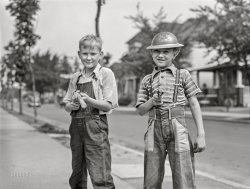
- Headquarters: 1942
- ... 1942. "Detroit, Michigan. Children." Acetate negative by John Vachon for the U.S. Foreign Information Service. View full size.
... Posted by Dave - 08/12/2023 - 2:52pm -
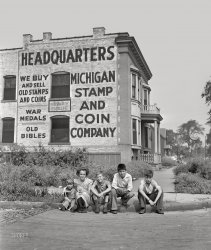
- Record Time: 1940
- ... View full size. Medium format safety negative by John Vachon for the Farm Security Administration.
That is.... a VERY ... Posted by Dave - 06/28/2008 - 9:29pm -
![Record Time: 1940 May 1940. Crawford County, Illinois. "Daughter of Farm Security Administration rehabilitation borrower listening to phonograph." View full size. Medium format safety negative by John Vachon for the Farm Security Administration.
That is....a VERY interesting 78 player.
Record TimeThe pensive, gentle smile on the face of this beautiful little girl reveals that the music has transported her mentally out of the austere and sparse reality of her worn surroundings. In her mind she may not be sitting on a broken chair in patched coveralls, wearing shabby shoes and contemplating a future of hard work and poverty, but instead is entertaining a young girls fantasy of a glamorous, prosperous life somewhere over the rainbow. One wonders what the record was that took her away to a better place, if only for a few minutes. This is a very appealing, provocative and thoughtful photo. Thank you.
[Or maybe John Vachon said Kid, sit in that chair and make like you're listening to a record. - Dave]
VelvetWhat that box is that says "velvet" on the shelf?
[Tobacco. - Dave]
BeautifulExcellent image.. I love B & W...
PhonographBrunswick phonograph with Ultona head, ca. 1918-
Brunswick PanatropeThis particular model would have been considered ancient technology by the time this little girl sat down to listen to it, indicating her level of poverty. The early Brunswicks played acoustic records, meaning the original artist or musician sang or played as loud as possible into a large horn leading to the recording stylus. Brunswick didn't start recording electrically until 1925, when they used the unusual Panatrope system (recording by light waves rather than a microphone). The wheels on this model suggest that it was a schoolhouse model that could be moved around easily, so my guess is this little girl's phonograph was donated to charity by a local school or church. My opinion, of course, hardly a fact.
[Panatrope was the name of the phonograph; Pallotrope was the recording system, which used a photoelectric microphone. Link 1, Link 2. - Dave]
PhotographYou got some kinda hold on me
You're all wrapped up in mystery
Two possibilitiesI kind of wondered why she was sitting so close, and here are my guesses. 1) Deaf or hard of hearing. 2) Needle is bad and needs to be changed, or record is worn out. Given the conditions the girl lived under, it was probably both a worn-out record and a bad needle.
[Third possibility: John Vachon plops a chair down next to the phonograph and says "Sit here, kid." - Dave]
PhonographI love the Brunswick phonograph. I have an Empire phonograph that's almost exactly like it.
Crank itNow in living color. Click to enlarge.
Looking for the GirlI came across this photo in the Library of Congress American Memory archives today. It was taken by Vachon in Crawford County, IL where I currently live. Chances are someone still living here knows who this girl is because of the accompanying photographs in the LC collection. The search begins. I love a good mystery!
(The Gallery, John Vachon, Rural America)](https://www.shorpy.com/files/images/8c17501u.thumbnail.jpg)
- Boiler Bros: 1942
- ... in the boiler room." Medium format acetate negative by John Vachon for the U.S. Foreign Information Service. View full size.
Boiler ... Posted by Dave - 07/06/2023 - 6:12pm -
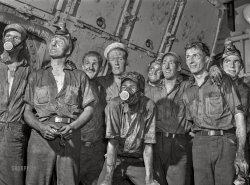
- Waiting to Inhale: 1942
- ... Class in artificial respiration." Acetate negative by John Vachon. View full size.
Hey, Sailor The habitual ...
(The Gallery, Bizarre, John Vachon, NYC, Swimming, WW2) ... Posted by Dave - 07/07/2023 - 10:08am -
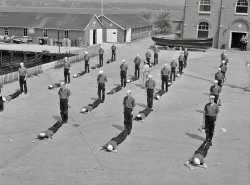
- Resting Bro Face: 1938
- ... at Irwinville Farms, Georgia." 35mm nitrate negative by John Vachon for the Resettlement Administration. View full size.
The boredom ... Posted by Dave - 02/24/2022 - 2:12pm -
![Resting Bro Face: 1938 May 1938. "Farm boy in the cooperative store at Irwinville Farms, Georgia." 35mm nitrate negative by John Vachon for the Resettlement Administration. View full size.
The boredom of waitingTo me he looks like a teenage guy waiting for his mother and sister to FINALLY make up their minds.
The thumb, ring finger, and pinky on his left hand look like they've been mangled.
Ennui are heWhen his subjects were human, John Vachon somehow knew how to probe their psyches with his lens and reveal things that mere body language does not. It's the totality of the photo: the boring, inanimate dry goods as a backdrop for bored youth is as eloquent as it is ordinary, and transcends time.
Transcending timeMs. Pennifer has it right. Vachon is pretty good at seemingly spanning time in this photo. To me, those bolts of cloth appear to be wrapped in plastic -- a thing that didn't happen until some time past 1938.
In the early 1960s I worked after school at a variety store that sold dry goods and most of the bolts of cloth were wrapped in brown paper of left fully uncovered. Watch the straight pins when unpacking!
[The photo, along with hundreds of others taken by John Vachon and his fellow FSA photographers at Irwinville Farms, is from the 1930s. Cellophane was invented over a hundred years ago. Below, a 1936 ad for "Cellophane transparent wrapping." - Dave]
(The Gallery, Agriculture, John Vachon, Stores & Markets)](https://www.shorpy.com/files/images/SHORPY-8a03440a.thumbnail.jpg)
- A Drink at the Sink: 1938
- May 1938. "John Pope, son of farmer, at Irwinville Farms, Georgia." Indoor plumbing was an ... the Dust Bowl years of the Great Depression. Photo by John Vachon for the Resettlement Administration. View full size.
Drink ... Posted by Dave - 11/08/2012 - 8:04pm -
![A Drink at the Sink: 1938 May 1938. "John Pope, son of farmer, at Irwinville Farms, Georgia." Indoor plumbing was an improvement for many of the sharecropper families resettled here by the government during the Dust Bowl years of the Great Depression. Photo by John Vachon for the Resettlement Administration. View full size.
DrinkFor some reason water always seemed colder and better from these porcelan dippers.
Drinking PailsMy grandmother and great grandmother, who lived together, always had a pail just like this by the sink for drinking. Even though I always used a glass at home, when I visited I always used the pail. Somehow, the water tasted better.
Stylin'Wow! Way ahead of the times! An undermount sink!
Notice the handle on the floor?A twist of that handle shuts the water off and drains the water line to below grade where the water won't freeze overnight after the stove becomes cold.
Young JohnI believe this to be John Bennett Pope b Colquitt Georgia 3/23/33 to James (b 1906), a farmer, and Ethel Clare (b 1904) a teacher of literary arts at Irwin County Public School earning $420 pa for 28 weeks work in 1939/40. John died 5/20/95.
According to the 1940 census the family lived in Militia District 901, Irwin, Georgia, can a Shorpyite explain why a Militia District please?
[Google is your friend. - tterrace]
thanks, and I thought the electoral college was complicated!
What our ladle is forWe have a "ladle" shaped in exactly that large "cup" shape. It's about a foot long, glazed with white porcelain, and has a red rim and handle. The handle has a hook at the end, however.
I always wondered what it was used for. It's too large for spooning soup or gravy, or other kitchen purposes. We've just used it as a decoration.
Now it's obvious: it belongs on the rim of a water barrel or bucket.
(The Gallery, John Vachon, Kids, Kitchens etc.)](https://www.shorpy.com/files/images/SHORPY_8b29323a.thumbnail.jpg)
- The Right Connections: 1942
- ... University of Nebraska, Lincoln." Acetate negative by John Vachon. View full size.
It's a test Keep trying those plugs, ... Posted by Dave - 05/12/2023 - 9:08am -
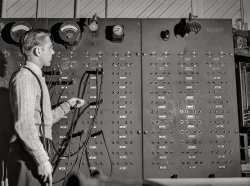
- Meet the McRaiths: 1942
- ... and family. He farms eighty acres." Acetate negative by John Vachon for the Office of War Information. View full size.
Mind over ... Posted by Dave - 08/14/2021 - 6:22pm -
![Meet the McRaiths: 1942 February 1942. "Meeker County, Minnesota. Mike McRaith and family. He farms eighty acres." Acetate negative by John Vachon for the Office of War Information. View full size.
Mind over MaterI just love the expression on Mom's face there. She looks mortified for some reason.
I'd rather have a bottle in front of me than ...Looks like Junior is just propped up against the furniture recovering from his frontal lobotomy.
The Wright name of the countyRobert Ried Reid, the author of "Picturing Minnesota: 1936-1943" (1989), interviewed Mike McRaith and his relatives in the late 1980s when writing the chapter of the book dedicated to the Vachon pictures of the McRaith family farms. He explained that Mike - one of ten children of Jerry and Fanny McRaith - and his brother Pat had managed the main farm owned by their parents and located in Meeker County. But "two years later Mike married and bought a 75-acre farm in Wright County near Montrose, some thirty-five miles from the McRaith farms." A footnote, citing a 1987 interview with John McRaith, explained that "the photographs of Mike and his family were taken near Montrose in Wright County, as indicated in the corrected captions."
https://www.google.com/books/edition/Picturing_Minnesota_1936_1943/IqPjx...
The "corrected captions" are apparently not on the Library of Congress versions of the photos.
WIsh we knew the backstory of these photographsI don't mean the history of the subjects themselves - the Shorpy community are a crackerjack corps of researchers.
What I'd like to know -
How did Vachon (and others) get these folks to sit for portraits? This one shows a respectable setting, but some of them show the subjects in settings which a proud person might well not choose to be portrayed to the world.
What did they tell the people about how to pose? This one frankly has some strange poses and expressions.
How did they decide which negatives to publish? It sure would be interesting to see the (probably lost forever) outtakes.
[Documentation, not publication, was the primary goal here. John Vachon's photos for the Farm Security Administration and Office of War Information are all online, including the dozens of pictures he took of the McRaiths. - Dave]
Twins?The two boys appear to be the same age; I'm guessing they're fraternal twins. The one sitting on the floor has been subdued, likely by his mother. The one on the tricycle has both his mother's worried attention and his father's hands poised to stop any sudden movements. "Please Mr. Vachon. Hurry up and take the picture!"
(The Gallery, Agriculture, John Vachon, Kids)](https://www.shorpy.com/files/images/SHORPY-8c20883a.thumbnail.jpg)
- Night Life: 1940
- ... November 1940. "Lincoln, Nebraska." Acetate negative by John Vachon. View full size.
Good Times Rollin' With the exception ... Posted by Dave - 12/15/2019 - 12:27pm -
![Night Life: 1940 November 1940. "Lincoln, Nebraska." Acetate negative by John Vachon. View full size.
Good Times Rollin'With the exception of the Ford (second from right), all of the cars photographed here are practically new. One has to wonder if a similar present-day scene would reflect a comparable degree of apparent prosperity.
Where drama meets detachmentAnother exquisitely haunting (and Hopper-esque) shot by Vachon, master of composition and light.
It's cold outside?I know it was late Fall when he shot this area, likely cold and wet, but seems like compared to other government photogs of the time, an awful lot of his were just shot out his hotel room windows.
[John Vachon shot more than 11,000 exposures for the FSA. Less than one percent were "out his hotel room windows." - Dave]
Trouble with a capital "T"... and that rhymes with "P" and that stands for Pool! The first big step on the road to the depths of degradation -- at least according to Professor Harold Hill!
What a terrific picture.
(The Gallery, Cars, Trucks, Buses, John Vachon)](https://www.shorpy.com/files/images/SHORPY-8c18315a.thumbnail.jpg)
- The King Sisters: 1965
- ... King Family on ABC-TV." 35mm Kodachrome transparency by John Vachon for Look magazine. View full size.
How I wish ... I was there ... Posted by Dave - 04/08/2023 - 4:13pm -
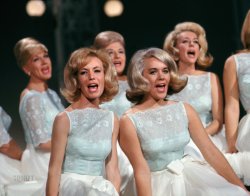
- Honeymoon Hotel: 1941
- ... View full size. Medium format safety negative by John Vachon for the FSA. This was scanned from an uncaptioned and somewhat misfiled ... Posted by Dave - 06/28/2008 - 11:11am -
![Honeymoon Hotel: 1941 August 1941. "Boardinghouse in Baraga, Michigan," a.k.a. the Honeymoon Hotel. View full size. Medium format safety negative by John Vachon for the FSA. This was scanned from an uncaptioned and somewhat misfiled print of the negative. Thanks to Anonymous Tipster for pointing us in the right direction (north).
Wait, Toto, we are in KansasI would guess this was in Kansas. Not many, if any, of these Second Empire style houses in Oklahoma. Kansas had the earlier settlements that would have built in this style, when Oklahoma was Indian Territory.
[This call number for this photo puts it in a batch of pictures taken in Cimarron County, Oklahoma, in April 1936. - Dave]
No, no Toto, we are in Michigan!Yay, finally a photo from my home area. This is the old Honeymoon Hotel in Baraga, Michigan, on the Keweenaw Bay Indian Reservation in the Upper Peninsula. This view looks east toward downtown Baraga and across the bay of Keweenaw with the town of L'Anse on the far side. For another view of this once stately building, see:
http://www.highway41north.com/baraga.html
Scroll down to 1940's, pictures #3 and #4. Thanks to Shorpy for this photo even though not as intended but perhaps it will open to its viewers an area that is rich in Indian, fur trade, lumbering, mining history and say, saloons, houses of ill-repute, safehavens for 1930's Chicago gangsters, and yes, I work in a building just a stone's throw from where this photo was taken....
[Oklahoma, Kansas ... Michigan. And it's by John Vachon, not Arthur Rothstein. From 1941, not 1936. So I was pretty close! Caption updated. Thanks. - Dave]
Not another view - same photoVery interesting - the picture #3 that you reference isn't just another view of the same building - as far as I can tell it's the exact same photo. Makes one wonder about the path they've both taken to make it onto the web. Presumably the picture#3 image is scanned from a print...
[Pics #2 thru #5 on Highway41north.com are all from the LOC archive and were taken by John Vachon. #3 is a low-res scan of a negative; our photo was scanned from a print. - Dave]
Some honeymoon!Lovely accommodations for Mr. and Mrs. Bates.
While in the neighborhood....The buildings noted in Highway41north.com, #2, #3/#4 are long gone but St. Anne's Catholic Church in #5 looks pretty much the same however it has an addition towards the rear and some needed landscaping around the steps....
Looks Like a Hopper PaintingThat sky is spooky. Not a soul in sight. Amazing photo.
Cool! My jaw dropped when I saw the pic and caption! I grew up in this area, and it's always fun to stumble upon these things on the web!! Thanks for posting, and thanks to the previous poster for the website with all the other pictures! I am a sucker for history and historical buildings and how things were back then.... This is a very haunting building... I love the ambience of it.
Very cool!
Forty years earlier...The hotel 40 years earlier.
(The Gallery, John Vachon, Rural America)](https://www.shorpy.com/files/images/8c36807u.thumbnail.jpg)
- Buy War Bonds: 1942
- ... commencement week." Medium format acetate negative by John Vachon. View full size.
The Nut House is no more Here is a photo ... Posted by Dave - 05/13/2023 - 12:51pm -
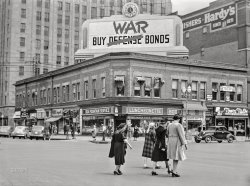
- The Parlor Door: 1940
- ... to little-used parlor." Medium format acetate negative by John Vachon for the Resettlement Administration. View full size.
Flashback! ... Posted by Dave - 11/24/2019 - 1:43pm -
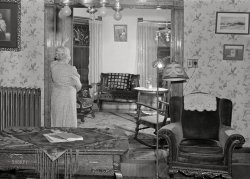
- Unknown: 1937
- ... film shot by Farm Security Administration photographer John Vachon in 1937. View full size.
Lookalike Brian Williams?
Cute ... Posted by Dave - 01/02/2008 - 1:37pm -
![Unknown: 1937 Unidentified man in an uncaptioned frame from a roll of 35mm film shot by Farm Security Administration photographer John Vachon in 1937. View full size.
LookalikeBrian Williams?
CuteWhoever it is, he's handsome. :3
Mr. CI was thinkin' more like Perry Como taking a break during a whirlwind tour with the Ted Weems Orchestra...
Mystery ManSome nearby frames below. Top one taken in a mirror, probably JV himself. The holes, made with a paper punch, mean he didn't want prints made of these. There was a punch in the main pic too, which I managed to Photoshop out.
Now, I think....It may be a self portrait of Vachon.
Check out this link---
http://www.ucpress.edu/books/pages/8917/8917.samples.pdf
page 2
[Those are some great photos. But Vachon had a narrower face (below). - Dave]
Whoever he isI find the photo strangely sexy. I'm not entirely sure why!
I think...it's Warren Beatty, Sr.
[I thought the same thing. 1937 is the year Warren was born. - Dave]
Mystery menYeah, top guy has to be JV - check out that head of hair, looks like he has an advancing hairline. (I used to have hair- *sigh*) The bow tie guy looks somewhat like Truman Capote- until he smiles. And then there's Warren Beatty.
Quite a stellar lineup.
Hello HollywoodIf this kid has any kind of a voice at all, he has a career calling in Hollywoodland. I'm not Gay, but I must say, this dude is good lookin'! Wow!
(The Gallery, John Vachon)](https://www.shorpy.com/files/images/8a03090u.thumbnail.jpg)
- Baby Sitting: 1939
- ... this is you, please let us know! 35mm nitrate negative by John Vachon for the Farm Security Administration. View full size.
IT'S ... Posted by Dave - 05/17/2011 - 3:54pm -
![Baby Sitting: 1939 September 1939. "Untitled." If this is you, please let us know! 35mm nitrate negative by John Vachon for the Farm Security Administration. View full size.
IT'S NOT METhought I'd let you know.
Reduces the number of possibilities by one.
NormallyOne could expect the guys to holler, "IT'S NOT MINE!" They suppose the 70+ years exempt them.
This child looks to be a few months older than my mother-in-law. She's still with us. Both the subject and its mother may be, too.
Narrowing it downThe rest of Vachon's September 1939 photos in the LOC archives are from three resettlement administration project sites in Wisconsin (in Greendale, Vernon County and Dane County), and industrial sites in Minneapolis. Based on those photos, my money is on Greendale.
[More than those three. Baby's neighbors in the archive are a Vachon photo dated September 1939 snapped in Washington, D.C., at Union Station, and another taken in Milwaukee. - Dave]
Pinned DownInteresting technique - pinning the shirt to the diaper. Probably very common, but I never thought of it before.
Clear EyesWhat a stunning, clear-eyed baby!
Obviously well-cared for, happy and healthy.
It's not me eitherI looked so much like a chimpanzee that people were forever offering my mom a banana for her "little one."
(The Gallery, John Vachon, Kids)](https://www.shorpy.com/files/images/8a04360a.thumbnail.jpg)
- Hello, Goodbye: 1942
- ... at Greyhound bus depot." Medium format acetate negative by John Vachon for the U.S. Foreign Information Service. View full size. ... Posted by Dave - 08/13/2023 - 3:33pm -
